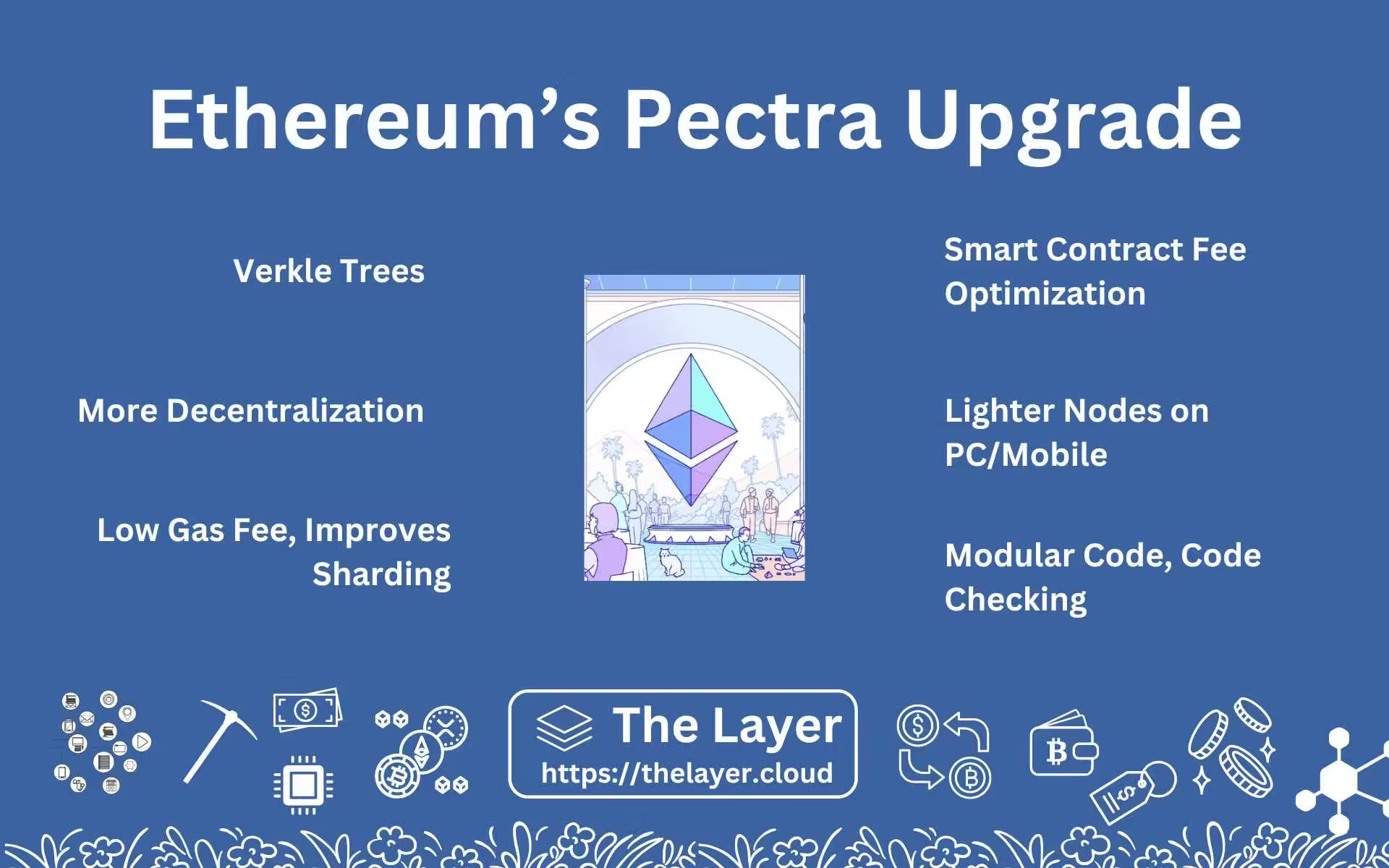Ethereum’s Pectra Upgrade is a part of the Verge Series of Upgrades that seek to make Ethereum lighter, safer, more decentralized, and more resistant to attacks.
It packs a series of upgrades with the most significant ones being Verkle Trees that will make Ethereum more lighter and decentralized.
Targets
Verkle Trees
Verkle Trees are an enhanced version of Merkle Trees that use Vector Commitments. This advanced cryptographic technique allows data to be securely committed, and when proof of that commitment is needed, it doesn’t require retrieving the entire dataset. Instead, a lightweight proof can be provided, making the process more efficient.
Stateless Verification
Stateless Verification will allow Ethereum nodes to add new blocks to Ethereum without having to download the entire blockchain. This upgrade will support smaller devices like standalone PCs, laptops, and mobile phones to become nodes and would be helpful in onboarding “solo validators”.
Promoting Decentralization
The upgrade will make it possible to run Ethereum on a single standalone device. Along with a reduced staking threshold of 1 ETH to become a validator, this upgrade will increase the validator count from 1 million to over 10 million.
EIPs Inside the Pectra Upgrade
Here’s a brief overview of each of the Ethereum Improvement Proposals (EIPs):
EIP-2537: Precompile for BLS12-381 Curve Operations
- Purpose: Introduces a precompiled contract for performing cryptographic operations on the BLS12-381 curve, which is a pairing-friendly elliptic curve.
- Use Case: Primarily used in Ethereum 2.0 for signatures in proof-of-stake (PoS) and in zk-SNARKs. It boosts efficiency for aggregating signatures and performing zero-knowledge proofs.
EIP-2935: Save Historical Block Hashes in the State
- Purpose: Proposes saving historical block hashes in the Ethereum state instead of recalculating them on the fly.
- Use Case: This would make historical block lookups faster and more efficient, improving functions that rely on block hash data.
EIP-6110: Supply Validator Deposits On-chain
- Purpose: Aims to store validator deposits directly on the Ethereum chain instead of managing them separately.
- Use Case: Increases transparency and accessibility for validators, making their deposits easier to track on the blockchain.
EIP-7002: Execution Layer Triggerable Exits
- Purpose: Allows the execution layer to trigger validator exits without going through the consensus layer.
- Use Case: Provides more control for validators to exit in a more flexible and efficient manner, aiding in the operational management of the network.
EIP-7251: Increase the MAX_EFFECTIVE_BALANCE
- Purpose: Proposes an increase in the maximum effective balance of Ethereum validators.
- Use Case: Raising the cap allows for higher staking rewards and balances, potentially improving validator incentives and network security.
EIP-7549: Move Committee Index Outside Attestation
- Purpose: Suggests moving the committee index (a key component in the validation process) outside the attestation.
- Use Case: Simplifies Ethereum’s attestation structure in the consensus layer, making the process cleaner and reducing complexity.
EIP-7594: PeerDAS – Peer Data Availability Sampling
- Purpose: Introduces PeerDAS, a method for sampling the availability of data across peers in the network.
- Use Case: Enhances data availability checks in the Ethereum network, helping ensure that validators have access to all necessary data for validation.
EIP-7685: General Purpose Execution Layer Requests
- Purpose: Generalizes the handling of requests between the execution layer (transactions, smart contracts) and other parts of Ethereum.
- Use Case: Makes interactions between Ethereum’s execution layer and other system components more flexible, enhancing cross-layer communication.
EIP-7702: Set EOA Account Code for One Transaction
- Purpose: This proposal allows an externally owned account (EOA) to temporarily execute code for a single transaction.
- Use Case: This would enable smart contract-like functionality for EOAs for specific transactions without requiring persistent code.
EIP-7692: Meta EIP Including Several Improvements
This EIP is a meta proposal that includes multiple smaller EIPs for optimizing the Ethereum Virtual Machine (EVM) structure. The included EIPs are:
- EIP-663: SWAPN, DUPN, and EXCHANGE Instructions: Add new instructions to improve EVM performance and reduce gas costs.
- EIP-3540: EOF (EVM Object Format) v1: Introduces a new object format for EVM to modularize code and improve contract efficiency. By doing so contracts will be able to use already present code on the Ethereum Virtual Machine and pay lesser gas fees.
- EIP-3670: EOF – Code Validation: Introduces code validation at the EOF level to ensure that contracts are well-formed and safe. This would help prevent contract manipulation to create vulnerabilities as well as prevent unintentional ones.
- EIP-4200: EOF – Static Relative Jumps: Replaces dynamic jumps in EVM with static jumps, improving security and predictability.
- EIP-4750: EOF – Functions: Introduces function definitions in the EOF to better organize code and improve EVM performance.
- EIP-5450: EOF – Stack Validation: Validates stack usage to avoid common stack-related bugs and errors.
- EIP-6206: EOF – JUMPF and Non-Returning Functions: Adds specialized jump instructions for non-returning functions, optimizing execution.
- EIP-7069: Revamped CALL Instructions: Improves the efficiency and consistency of CALL instructions in EVM.
- EIP-7480: EOF – Data Section Access Instructions: Provides new instructions to handle data sections, making contracts more efficient.
- EIP-7620: EOF Contract Creation: Optimizes the process for contract creation in the new EOF format.
- EIP-7698: EOF – Creation Transaction: Improves how transactions create new contracts, specifically when using the new EOF format.
In Line With Merge and Surge (Dencun, Sharding)
The Verge series of upgrades starting with the Pectra Upgrade will be critical in ensuring Merge and Surge series get the support they need.
This is because Merge makes Ethereum transition to Proof of Stake which could make it more vulnerable. With the increase in validators after the Pectra Upgrade, this vulnerability will reduce significantly.
Further, the final upgrade of Sharding in Surge Series of Upgrades would require a far more validators to be able to divide the entire consensus protocol into smaller shards that will act independently to add new blocks to the blockchain.
How Will The Upgrade Impact Me?
Lower Gas Fees
Since the number of validators will increase, Ethereum can implement Sharding very easily which will then decrease the transaction fees significantly.
Further with EIP 3540, it will decrease Ethereum’s smart contract deployment fee and invite far more developers and use cases on Ethereum.
More Decentralization
With reduced staking fees and lighter devices required, Ethereum will be far more decentralized than ever. I suppose the number of validators might even cross 10 or 15 million.
More Secure Transactions
The increased number of validators will make the network more secure than ever.
Further with EIP 4670 the code validation will prevent codes with loopholes from being deployed on Ethereum.




